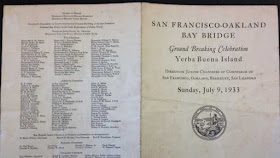Today we celebrate the 83rd anniversary of the groundbreaking for the San Francisco-Oakland Bay Bridge. The bridge was first called the James “Sunny Jim” Rolph Bridge to pay homage to the city’s then mayor and governor. However, he was not able to witness the opening of the inauguration of the bridge due to his passing two years before construction was completed. The official and functional name of the bridge thus became the San Francisco-Oakland Bay Bridge and is commonly called "Bay Bridge". When it was built, the bridge totaled a length of 23, 556 feet (8.25 miles including the East Bay crossing and the approaches in San Francisco) and was the world’s longest steel structure.
 | ||||||
| Gov. James Rolph, Mr. Herbert Hoover and others including Miss Alameda, Miss SF Bay Bridge, and Miss San Francisco at groundbreaking ceremony for the construction of the Bay Bridge, July 9, 1933, courtesy, California Historical Society, CHS2013.1290 [b]
On July 9, 1933 the California Department of Public Work
broke ground and a 1-day ceremony was held to honor this event. Though actual
construction work had begun in May with an informal ceremony at the site of the
West Anchorage, a large crowd gather at Yerba Buena Island for a ceremony that
included ex-President Herbert Hoover as a keynote speaker and performances by the
Young Women of Bay Cities and the United States Navy Band. An airplane flight linked
Rincon Hill and Oakland with a symbolic bridge of smoke and then President
Franklin D. Roosevelt set a simultaneous detonation of blasts at Yerba Buena
Island, San Francisco, and Oakland. Governor Frank Meeriam broke the ground
assisted by San Francisco Mayor James Rolph.
The bridge was designed by the California Department of
Public Works under its Chief Engineer Charles H. Purcell, Bridge Engineer Charles
E. Andrew, and Design Engineer Glenn Woodruff. The turbulent water conditions
(varying soils and water depths), inaccessibility to bedrock, gusty winds, and
a host of other unique design challenges made the building of the bridge seem impossible.
Engineers also assumed that the area’s high winds posed a greater threat than
earthquakes, despite the bridges proximity to two major fault lines. Part of
these natural hurdles to construction were overcome by building the bridge in
two different sections connected by a tunnel through Yerba Buena Island. Political
forces also prevented construction. Plans to build a bridge between San
Francisco and Oakland had been discussed since the 1870s, but did not move
forward until the Reconstruction Finance Corporation, with support from
President Herbert Hoover, agreed to purchase bonds to be repaid later with
bridge tolls. At last on November 12, 1936 the Bay Bridge opened and in its
first year carried 9 million vehicles (102,200,000 per year today). The traffic
levels that year exceeded expectations for 1950. Local residents now had a
quick way to drive between the rapidly growing cities of San Francisco and
Oakland: the East and West communities of the Bay Area were brought together like
never before.
Due to the 1989 Loma Prieta earthquake, the steel supports
of the damaged decks shifted, slicing off five-inch steel bolts that connected
the deck to the supports. This partial collapse required $6.4 billion towards
reconstruction and after nearly a decade of construction and 24 years after
Loma Prieta, the bridge opened again on September 2, 2013. The self-anchored
suspension span was designed to withstand the strongest quake estimated by
seismologists to occur at the site over a 1,500 year period.
Today an average of 270,000 vehicles cross the Bay Bridge
each day. It remains a beautiful and important historical landmark and exudes
an aura of magnificence, thus making it one of the favorite tourist spots in the
area. Visitors can stroll along the beaches under the bridge, enjoy a picnic
around the area, bike across the bridge, and simply enjoy the view and
peacefulness.
Sources
American Philatelic Society
Associated Press in San Francisco, “San Francisco-Oakland Bay Bridge
Opens To Traffic After Years Of Delays”
“Bay Bridge History” | Key Facts
Michael Cabanatuan, “Bay Bridge Eastern Span Opens”
“Oakland Bay Bridge”
“San Francisco–Oakland Bay Bridge”
“The California Quake: The Bay Bridge; Damage To Link Across
Bay Is More Serious Than Thought”
“The San Francisco/Oakland Bay Bridge”
|






No comments:
Post a Comment